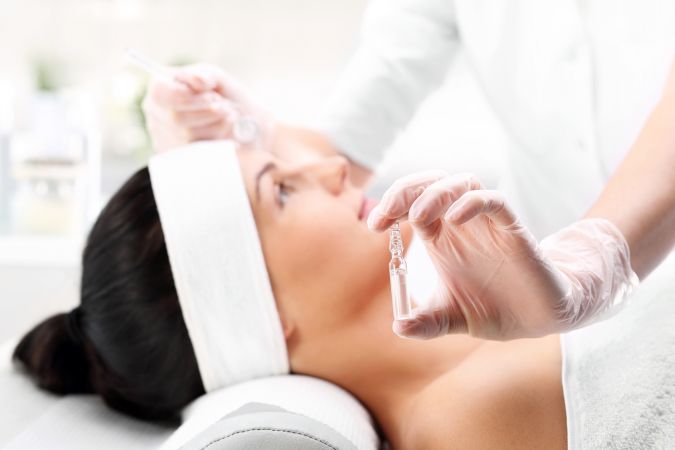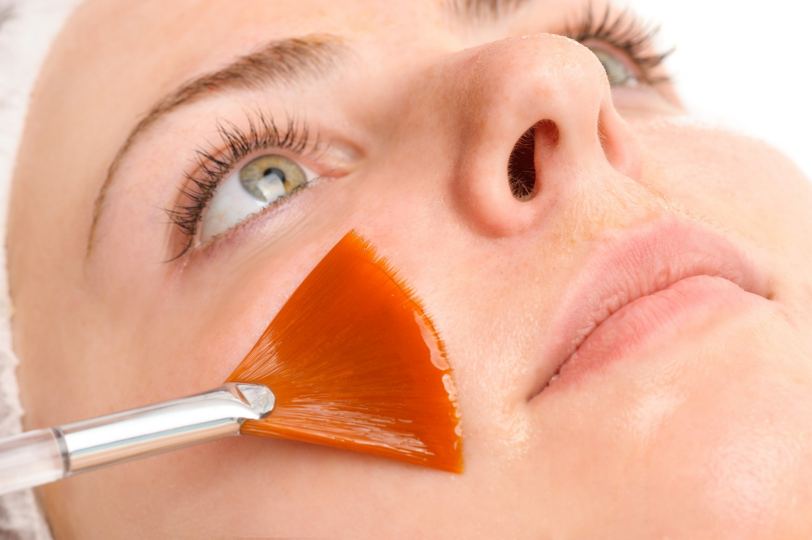Acne – therapy of active inflammatory lesions consists primarily in the use of products with a strong anti-inflammatory exfoliating effect. Such properties characterize medical peels, especially mandelic and salicylic acid. Mandelic acid is indicated primarily for impure skin, with acne papules and pustules,with acne rosace. With discoloration that react badly to other alpha hydroxy acids.
An important contraindication to the use of mandelic acid is allergy to almonds and nuts. In turn, salicylic acid is recommended for thick, oily, seborrheic skin with pimples and papules.
Salicylic acid
applied in high concentration to acne lesions causes the lump to separate from the epidermis and thus cleanse the skin. It is characterized by astringent, keratolytic, antibacterial and antiseptic effects. An important contraindication to the use of salicylic acid is allergy to the acid and its derivatives (e.g. aspirin). In the treatment of inflammatory changes in acne, a very important aspect is the regularity in performing procedures. A series of treatments is from 4 to 8, every 2-3 weeks. Treatments with mandelic and salicylic acid can be performed all year round taking into account strong SPF 50 photoprotection.
After the procedure, it is worth giving up makeup for a few days.
In order to allow proper cleaning and peeling of the skin. The skin may be irritated and sensitive immediately after the procedure. But it is a temporary symptom and it quickly disappears. After a few days, you may notice skin peeling. In the case of mandelic acid, this will be fine-leaf exfoliation. However, exfoliation after application with salicylic acid is noticeable primarily in places where there was an inflammatory efflorescence. In a situation where inflammatory changes occur individually or only locally (e.g. in the T zone-you can combine mandelic and salicylic acid in one treatment procedure. Then apply salicylic acid to the skin with inflammatory lesions, and apply the remaining parts with mandelic acid.
Another type of chemical peeling is PRX-T33,
which is registered as a medical device. The product contains 33% trichloroacetic acid (TCA), 5% kojic acid and hydrogen peroxide. Despite the high TCA concentration in the product, the treatment does not cause peeling of the epidermis, but it stimulates fibroblast growth factors. In turn, kojic acid and hydrogen peroxide are characterized by lightening discoloration. The treatment is indicated for the treatment of acne scars, reduction of blackheads and discoloration. Nowadays, more and more adults are struggling with the problem of acne. PRX-T33 can also be used as a combination of anti-acne and anti-aging treatments. The treatment will improve skin firmness, elasticity and reduce wrinkles.
To increase the intensity of the treatment and improve the skin structure, the PRX-T33 treatment can be combined in one treatment procedure with micro-puncturing. PRX-T33 is a medical peeling that can be used in up to 12 children as a treatment for smallpox scars, which means it is a very safe product. The procedure can be performed throughout the year, and strong photoprotection is recommended, but not mandatory.
Another treatment recommended for acne-prone skin is the Mediderma 3-Retises CT Yellow Peel procedure.
Similarly to PRX-T33, the treatment can be used as an intensive anti-aging treatment, discoloration, stretch marks or scars therapy. 3-Retises CT Yellow Peel consists of two products that are massaged into the treatment area. The first is the ampoule, which contains vitamin C in various chemical forms (which results in action at different skin depths) and niacinamide (anti-inflammatory). Then comes the application of a mask with 3 forms of retinol (which strongly stimulates the skin to revitalize, rebuild), hyaluronic acid (highly moisturizing) and zinc (anti-inflammatory and healing). The mask is massaged into the skin and remains on it for 8 hours. After this time, the client washes the product off with lukewarm water. The treatment series consists of 4-6 treatments every 3-4 weeks. Strong photoprotection is necessary to prevent new discoloration.
After silencing skin inflammations, it is worth performing an iPixel laser peeling at the beauty salon.
It is a fractional ablation laser – it means that with the help of a micro laser beam the tissue is evaporated. IPixel strongly stimulates the skin to rebuild, improves its structure, smoothes the surface, reduces blackheads and papules. Another advantage of the procedure is the fact that the cosmetologist selects the parameters and the number of transitions to the problem of the treatment area. Therefore the tissue requiring stronger stimulation (e.g. scar) may be better developed. After the treatment, the skin will be very red. You may also feel a burning sensation (like after a thermal burn). After a few days brown crusts will form in the places of the micro-injuries.
It is important that the client after the treatment cares for the treatment area. Keep all aseptic measures, wash the skin with a mild cleansing product. Rinse with lukewarm water and wipe with a disposable towel. It is also recommended to lubricate the wound with a product accelerating healing and not to peel off the scabs! Strong photoprotection is necessary and lasts at least 1 month, otherwise discoloration may appear as a complication after the procedure. IPixel can be done in series every 4-6 weeks, depending on skin healing and parameters.
IPixel can be included in any series of acne treatments. Should be an appropriate interval between treatments (of at least 4 weeks).
It should be remembered that inflammation at the place of treatment is a contraindication to laser therapy.
Book an appointment at a convenient time using the online form










